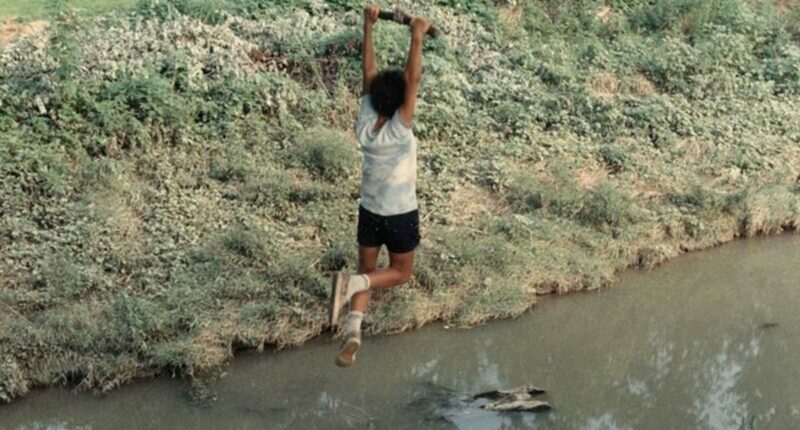Share this @internewscast.com
A chilling new study has confirmed the fears of generations – that children who grew up near a Missouri creek polluted by nuclear waste from the first atomic bomb project are suffering from elevated rates of cancer rates.
The findings have been published this week in JAMA Network Open by researchers at the Harvard T.H. Chan School of Public Health and provide the clearest evidence to date linking radioactive contamination in Coldwater Creek, a tributary of the Missouri River north of St. Louis, to long-term cancer risks in nearby residents.
‘Our research indicates that the communities around North St. Louis appear to have had excess cancer from exposure to the contaminated Coldwater Creek,’ said Marc Weisskopf, professor of environmental epidemiology and physiology at Harvard and corresponding author of the study.
Weisskopf’s team found that individuals who lived within one kilometer of the creek as children between the 1940s and 1960s were significantly more likely to develop cancer later in life.
They believe the cancer is a result of ionizing radiation exposure from the creekbed, soil, and water.
The source of the contamination dates back to one of the darkest and most secretive chapters in US history: the Manhattan Project, the clandestine federal initiative that developed the world’s first nuclear weapons.
Mallinckrodt Chemical Works, operating in downtown St. Louis, was responsible for processing uranium used in the atomic bomb dropped on Hiroshima in 1945.
But after the war, barrels of radioactive waste were moved to open-air storage sites near Coldwater Creek, where they remained for years, exposed to rain, wind, and runoff.

Generations of families played in Coldwater Creek which has resulted in thousands of people developing life-threatening cancers and other illnesses Pictured: A 1980s picture of a boy using a rope swing to jump into Coldwater Creek

The radioactive waste from the plant was kept for years in barrels next to Coldwater Creek. Barrels full of waste were piled on top of one another

The above map shows the cancer rate per 100,000 residents in each Missouri county between 2017 and 2021. The rate in St Louis County is 458 per 100,000 people in that four-year period
Those toxins, including uranium and thorium, leached into the soil and water, contaminating the surrounding environment and putting thousands at risk, especially children, who played in the creek, dug in the dirt, and breathed in radioactive dust kicked up during gardening or construction.
Now, decades later, the health toll is becoming undeniable.
The Harvard study, based on a cohort of 4,209 individuals who lived in the Greater St. Louis area between 1958 and 1972, found that 24% reported having cancer.
Among those living closest to the creek, that number rose to 30%.
‘Our study found that children in the 1940s to 1960s who lived near Coldwater Creek… had a 44% higher risk of cancer compared to those living further than 20 kilometers away,’ said co-author Michael Leung, a postdoctoral fellow at Harvard’s Department of Environmental Health, to Fox News.
The types of cancer reported include leukemia, thyroid, breast, and colon cancers are consistent with illnesses linked to radiation exposure.
For many in North St. Louis County, the revelation is both vindicating and heartbreaking.
Families who grew up splashing in Coldwater Creek or building homes nearby have lost loved ones to aggressive cancers – often with no explanation, until now.

Coldwater Creek (pictured) is labeled as one of the most polluted waterways in the US. It is connected to the Missouri River

The above map shows areas in St Louis County that have been plagued with clusters of rare cancers and other chronic illnesses

Steel drums containing radioactive waste were dumped near Coldwater Creek in the mid-1970s
The Harvard study suggests those deaths were not random but the byproduct of wartime secrecy, industrial negligence, and decades of environmental inaction.
While the researchers acknowledged limitations in their study, including its sample size and reliance on self-reported outcomes, the statistical signal is clear enough to prompt renewed concern and action.
The study comes at a pivotal moment. Last month, Congress passed an expanded version of the Radiation Exposure Compensation Act (RECA) as part of President Trump’s ‘Big Beautiful Bill,’ offering financial relief for Americans harmed by nuclear testing and contamination – including, for the first time, residents near Coldwater Creek.
‘These findings may have broader implications – as countries think about increasing nuclear power and developing more nuclear weapons,’ Weisskopf warned.
‘The waste from these entities could have huge impacts on people’s health, even at these lower levels of exposure.’
Local families, activists, and health officials have long urged the government to take the cancer clusters seriously.
In July 2023, an investigation published by The Associated Press, The Missouri Independent and MuckRock showed that the federal government and companies responsible for nuclear bomb production and atomic waste storage sites in the St. Louis area were aware of health risks, spills, improperly stored contaminants and other problems but often ignored them.
The federal government formally acknowledged the contamination at Coldwater Creek in the 1980s, but efforts to clean up the area have been slow and piecemeal.
Now, armed with hard scientific evidence, those affected are hoping for accountability.

The creek extends 19 miles through north St Louis Country from the St Louis Lambert International Airport to the Missouri River

Coldwater Creek was contaminated when nuclear waste from the Manhattan Project flowed into the waterway past homes, schools and businesses

A no trespassing sign hangs on a fence around the West Lake Landfill Superfund site. St. Louis activists have been fighting for years to get government compensation for people with cancer and other serious illnesses potentially connected to Manhattan Project nuclear contamination
‘We hope these findings will support public health measures for affected communities, as well as ongoing efforts to remediate the creek,’ Leung said.
While nuclear workers had direct exposure, people who live near contamination sites worry about uncertainty. Many who grew up in the area weren’t told about the risks for decades.
In 2007, Chapman and Karen Nickel were so concerned about cancer and other unusual illnesses in their St. Louis County neighborhoods that they formed Just Moms STL.
In 2019, the federal Agency for Toxic Substances and Disease Registry issued a report that found people who regularly played in Coldwater Creek as children from the 1960s to the 1990s may have a slight increased risk of bone cancer, lung cancer and leukemia.
The agency determined that those exposed daily to the creek starting in the 2000s, when cleanup began, could have a small increased risk of lung cancer.
The government’s sloppy handling of nuclear contamination over decades has understandably made people doubt official promises that conditions are safe now, said Arjun Makhijani, a nuclear expert and president of the Institute for Energy and Environmental Research.
‘There is zero trust,’ he said.

Susie Gaffney poses for a photo along Coldwater Creek near where she used to live. The creek was contaminated when nuclear waste from the Manhattan Project flowed into the waterway. St. Louis played an important role in the country’s effort to build the first nuclear weapon

Jim Gaffney sits with fellow activists while discussing nuclear contamination. Gaffney, now in his 60s, grew up in the 1960s playing in Coldwater Creek. His childhood home backed onto it

In 2007, Karen Nickel, left, and Dawn Chapman were so concerned about cancer and other unusual illnesses in their St. Louis County neighborhoods that they formed Just Moms STL
People in the St. Louis area are concerned that more illnesses are caused by the contamination and some are pushing for legislation to compensate those who are sick. Others have sued those responsible for the waste.
Several people with serious illnesses, or whose loved ones are sick, met recently at Nickel’s house.
Jim Gaffney, now in his 60s, grew up in the 1960s playing in Coldwater Creek – his childhood home backed up to the waterway.
‘I was always in the creek,’ Gaffney said. ‘Told not to, but we had seven kids. Mom couldn’t watch us all. We just thought it was fun. We built mudslides and everything. I’m sure I got exposed.’
He and his wife, Susie, loved the neighborhood so much that when they got married, they moved into a home there. Their children grew up playing in a park that backs to the creek, Susie Gaffney said.
‘We had no warnings. We had no fears,’ she said.
Jim Gaffney was diagnosed with Stage 4 Hodgkin lymphoma in 1981 and given little chance to survive. A bone-marrow transplant saved his life, but the toll of the radiation, chemotherapy and the disease has been enormous.

Senator Josh Hawley, R-Mo spoke about the Radiation Exposure Compensation Act during a news conference on Capitol Hill in Washington last September

A member of the Navajo Nation holds holds a banner during a news conference about the Radiation Exposure Compensation Act on Capitol Hill in Washington

A duck is seen swimming in the Coldwater Creek in Florissant, Missouri
‘Now I’ve got hypertension, heart failure, I’ve had at least five bladder tumors removed since ´95. I’m still here, but it’s not been easy,’ he said.
The Gaffneys’ son Joe has battled thyroid cancer since 1998 when he was 18.
Tricia Byrnes swam in Weldon Spring quarries as a teenager. Eight years ago, her 15-year-old son was diagnosed with a rare cancer of the thymus, a small organ near the heart. She wonders about a connection.
Byrnes she became so frustrated with the lack of acknowledgement about the health risk at Weldon Spring that she successfully ran as a Republican for the Missouri House, where she is pushing for federal compensation for those who believe their illnesses are connected to contamination.
She said it’s infuriating that the federal government not only allowed the contamination that made people sick, but didn’t do enough to contain it.
‘What the hell is wrong with people?’ she asked.















